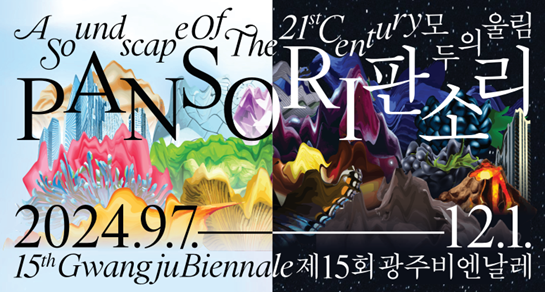Lahore Biennale Presents 2024 Edition “Of Mountains and Seas”
4 September 2024Manifesta 15 Barcelona Metropolitana Opens This Weekend
7 September 2024
Image courtesy of the Gwangju Biennale Foundation.
15th Gwangju Biennale
Pansori, a soundscape of the 21st century
September 7, 2024 – December 1, 2024
www.15gwangjubiennale.com
Coinciding with the Gwangju Biennale’s 30th anniversary, the 15th Gwangju Biennale Pansori, a soundscape of the 21st century embarks on its 86-day journey from September 7 to December 1, 2024. The Main Exhibition, curated by Artistic Director Nicolas Bourriaud, features 72 artists from 30 countries exploring sustainable contemporary spaces, creating a stage for discourse on the future of humanity and art. Additionally, the Gwangju Biennale Pavilion expands to 31 pavilions and a special program, organized by various countries, cities, institutions, and individuals, further establishing the Gwangju Biennale Pavilion as a center for the exchange of contemporary art. Throughout the Biennale, the entire city of Gwangju will be transformed into a vibrant center of cultural and artistic activity, showcasing a diverse array of contemporary works. The preview dates are September 5 –6, with an opening ceremony taking place on September 6.
Gwangju Biennale Foundation President Park Yang-woo stated, “The 15th Gwangju Biennale begins its 86-day journey from September 7 to December 1. With the Main Exhibition and the Gwangju Biennale Pavilion as mainstays, the 15th Gwangju Biennale will transform the entire Gwangju area into a diverse and experimental site for culture and art. Held on the 30th anniversary of the Gwangju Biennale’s establishment, it will serve as a turning point, for us to verify the essence of biennales and for the city of Gwangju to become Asia’s center point of cultural exchange.”
A cinematic journey into the possibility of coexistence of life and art
The 15th Gwangju Biennale Pansori, a soundscape of the 21st century, explores contemporary space through the narrative of pansori, a traditional Korean music form that combines storytelling with performance. The term pansori is a compound word: pan, meaning public space, and sori, meaning voice or sound. In pansori, the presenter, audience, and setting converge, highlighting the relationship between space and sound, performers and their environment, oftentimes signifying “noise from the public place where people gather” or “voice of the subalterns.” The exhibition reinterprets pan as contemporary space, closely examining the voices and sounds produced by its human, non-human, organic, and inorganic occupants.
In this exhibition, the voices of 72 artists from 30 countries metaphorically become part of a visual symphony, each contributing their unique perspectives. These artists, representing a wide range of generational, cultural, age, gender, and regional backgrounds, engage in a dialogue about a planet in crisis. The exhibition spans the Gwangju Biennale Exhibition Hall and eight venues in the Yangnim-dong area, integrating artworks into everyday spaces to explore whether life and art can coexist, fostering dialogue on sustainable space and the future with pansori at its core.
Sustainable Spaces
Disputed borders, anti-migration walls, confinement, social distancing, segregation policies… These seemingly dissimilar topics share a common point, which is space, and its political organization. The main effect of climate change is the emergence of a new topology, a new world map in which carbon dioxide and urban life, desertification and migration, deforestation and social struggles, destruction of animal habitats and vegetal invasions, have all become brutally interconnected. Pansori, a soundscape of the 21st century is an operatic exhibition about the space we live in, from housing to human settlement on the planet.
A landscape is also a soundscape, and this exhibition is constructed as a narrative, which connects musical and visual forms. Art is also a specific place, which allows us to re-think the space shared between humans, machines, animals, spirits, and organic life — our relational space. Space is also a crossroads that connects all emancipatory struggles, from feminism to decolonization and LGBTQ+ rights, as the division of space is always geopolitical. The artists in this exhibition address spatial issues either by representing contemporary landscapes and the urban condition, saturated with human presence, or the effects of industrialization upon natural ecosystems. Some open up our space by entering into dialogue with machines, animals, spirits, bacteria, and other life forms, or examining the molecular composition of the world. Still others work at a cosmic scale, inventing a contemporary shamanism. From extremely dense to desertified areas, Pansori, a soundscape of the 21st century presents itself as an opera you can walk into.
A ‘soundscape’ from Gwangju Biennale Exhibition Hall to Yangnim-dong
The 15th Gwangju Biennale is organized into sections with names derived from auditory metaphors. The audience can walk through the Gwangju Biennale Exhibition Hall and venues in Yangnim-dong, witnessing the transformation of the Anthropocene.
The ‘Feedback Effect’ (Gwangju Exhibition Hall Gallery 1 and 2) section shows the sound image of a planet, saturated with human activities, where relationships between humans and species have become dense and the space they inhabit, an echo chamber where everything is contiguous, contagious and immediate. In Oju 2.0 by Emeka Ogboh, a sonic exploration of finding harmony within chaos, the blended elements are punctuated by moments during which disparate street sounds reflect an underlying order within the natural disorder of a vibrant neighborhood. Mira Mann’s objects of the wind is a panoramic memorial dedicated to Korean nurses that worked in Germany, using pungmul, traditional Korean music rooted in drums, dancing and singing. Noel W. Anderson’s tapestries accompanied by a sound installation explore the material and conceptual implications of white supremacy in the development and representation of Black performance and prompt the connections and differences across varying struggles.
The ‘Polyphony’ section (Gallery 3) displays works of artists focusing on multi-layered and multi-focused perspectives. Phillip Zach’s new work soft ruin, an immersive painting with a cocoon-like structure, implies that the aftermath of residual spaces may birth entirely new worlds. For his large-scale performative installation LYSIS FIELD, Max Hooper Schneider uses visual acrobatics and fictions to present this moment of “lysis”—the point where a harmful substance breaks down and begins to regain its ecological value.
The ‘Primordial Sound’ section (Gallery 4 and 5) features artists who explore the non-human world, the cosmos and the molecular world in which carbon dioxide, tear gas and environmental hormones, droplets and viruses are the primary agents of history. The beginning of the cosmos presented using the first Big Bang noise, the Chinese Qi, the Buddhist Om, as a medium for primordial sound is also its vanishing point, an imaginative space, the exit and the alternative, another world. Artists expand their ‘beginnings’ to the origin of the world and the creation of the universe. Bianca Bondi’s The Long Dark Swim invites the viewer to immerse themselves into a receptive and passive state, to access an extra-sensory experience of space, as if in a dream. Josèfa Ntjam video installation, reminiscent of a spacecraft console, is used to visualize “alien” signals and tell the story of an unclassifiable bioluminescent organism. Marguerite Humeau’s installation stirs, includes an experimental pansori composition with voice and drum, recorded with musician and ex-Leenalchi band member, Song Hee, that conjures the emergence of the origin of life.
The exploration of contemporary spaces extends beyond the Gwangju Biennale Exhibition Hall into Yangnim-dong, a region that has long preserved the history and community spirit of the city of Gwangju. Visitors can meet twelve artists who are presenting sound projects and works that require audience participation in eight venues: Yangnim Cultural Fountain, Podonamu Art Space, Gallery Han Boo Chul, Old Police Station, Yangnim Salon, Han Hee Won Museum of Art, Empty House, and Horanggasinamu. Jayi Kim, who seeks serenity away from the frenzy and endless competition that drives modern society, attempts to reduce carbon footprints by transforming the Yangnim Cultural Center into a vast artificial garden, where she cultivates herbs with the help of local cafes, which are used to create beverages, offering eco-friendly consumption alternatives. Angela Bulloch’s Dynamic Stereo Drawing Machine uses motorized drawing mechanisms that respond to the music within the exhibition space to mark the paper surface. The playlist is based on songs and sounds shared by artists participating in the Gwangju Biennale. An explorer of transitional spaces, Saâdane Afif collaborates with pansori singer Sora Kim, transforming a former police station into a Pavilion of the Eternity using the abandoned building as a portal to a space of shared authority.
Artist List
Saâdane Afif, Haseeb Ahmed, Deniz Aktaş , Noel W. Anderson, Andrius Arutiunian, Kevin Beasley, Wendimagegn Belete, Bianca Bondi, Dora Budor, Peter Buggenhout, Angela Bulloch, Alex Cerveny, Cheng Xinhao, Choi Haneyl, Gaëlle Choisne, Anna Conway, Binta Diaw, John E. Dowell Jr., Hayden Dunham, Liam Gillick, Loris Gréaud, Matthias Groebel, Matthew Angelo Harrison, Marguerite Humeau, Agata Ingarden, Hyejoo Jun, Hyoungsan Jun, Hyeongsuk Kim, Jayi Kim, YoungEun Kim, Dominique Knowles, Agnieszka Kurant, Hyewon Kwon, Netta Laufer, Brianna Leatherbury, Yein Lee, Oswaldo Maciá, Mira Mann, Cinthia Marcelle, Vladislav Markov, Beaux Mendes, Myriam Mihindou, Na Mira, Saadia Mirza, David Noonan , Katja Novitskova, Josèfa Ntjam, Emeka Ogboh, Frida Orupabo, Lydia Ourahmane, Mimi Park, Philippe Parreno, Amol K Patil, Harrison Pearce, Lucy Raven, Tabita Rezaire, Marina Rheingantz, Marina Rosenfeld, Max Hooper Schneider, Franck Scurti, Soomin Shon, Jura Shust, Sofya Skidan, Anastasia Sosunova, Jakob Kudsk Steensen, Sung Tieu, Julian Abraham “Togar”, Unmake Lab, Yuyan Wang, Ambera Wellmann, Kandis Williams, Phillip Zach
Opening Ceremony featuring a contemporary pansori performed on stage that fuse regionality and globality
The opening ceremony of the 15th Gwangju Biennale will take place at Jungoe Park on September 6 at 6 PM. It begins with a declaration by Gwangju Biennale Foundation President Park Yang-woo, followed by welcoming remarks by Gwangju Metropolitan City Mayor Kang Ki-jung, and congratulatory speech by Minister of Culture, Sports and Tourism First Vice Minister Yong Ho Seong. An overview of the 15th Gwangju Biennale Pansori, a soundscape of the 21st century will be presented by Artistic Director Nicolas Bourriaud, followed by an introduction of the participating artists. Notably, the ceremony features a 30-minute special opening performance ‘Pansori on stage’ which embodies the theme of this year’s Biennale. Directed by Nicolas Bourriaud, the opening performance features nine artists, including writer Han Kang, pansori singer Laure Mafo with a drummer, Loris Gréaud, We Mu, Julien Abraham “Togar”, and Hayden Dunham. We Mu performs a pansori composition delving into stories about the soundscape of humans and objects. The composition is based on Han Kang’s writings on Gwangju which is also recited during the performance. The audience not only participates in the globalization of local, traditional culture but also experiences the interpretation and recreation of pansori.
Symposium and rich line-up of public programs
The 15th Gwangju Biennale Symposium titled Echoes of Tomorrow: Soundscapes in the Age of Advanced Computing will take place on September 8 at Theater 3 of the National Asian Culture Center(ACC). The symposium is hosted by the Gwangju Biennale Foundation in collaboration with Solomon R. Guggenheim Museum. Co-curated by Nicolas Bourriaud, Artistic Director of the 15th Gwangju Biennale and Dr. Noam Segal, LG Electronics Associate Curator at the Solomon R. Guggenheim Museum in New York, the symposium will present discourse on dynamic perspectives and artistic practices on sound and technology today.
GB Talks, a program for interdisciplinary dialogue and engagement, provides participants with the opportunity to interact with experts from various fields on a monthly basis. September’s session will feature two artist talks with Kandis Williams, Na Mira, YoungEun Kim, Amol K. Patil, Noel W. Anderson, and Mimi Park, as well as a workshop led by Jayi Kim.
Gwangju Biennale Academy 2024 International Curator Course, an open educational program established by Gwangju Biennale to cultivate professional curators, theorists and art administrators, is being held from August 29 to September 12 under the topic ‘Technological Innovation and the Curatorial Shift.’
A number of public programs will be offered during the exhibition period at Gwangju Biennale Geosigi Hall. GB Talks, a multidisciplinary program that invites experts and visitors from various fields to communicate, will be held once a month. Gwangju Biennale Education Program for Children will be available biweekly on every other Saturday from September 14, at 10 AM and 2 PM. A children’s docent program will also be offered once a month on Sundays at 2 PM.
The Buk-gu Art Bus and programs in collaboration with the Yangnim Alleyway Biennale will also take place during the exhibition period.



